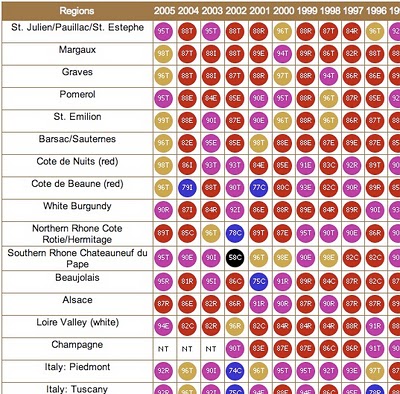
Thanks to Global warming and modern winemaking techniques, we have fewer poor vintages than in the past. We also seem to have more of the "great" vintages handed to us as well. I touched on this before. Time has passed, and now, I have dealt with the 2008 Rhone fallout.
The Southern Rhone has experienced a string of easy vintages. In the last 10 years they have had 9, really great years. With the consensus exception of the 2002 vintage, they were all vintages worth buying. The 2008, sandwiched between the 93pt-2009 Vintage and the 98pt-2007 vintage (heavily overrated in my opinion), received a measly 86 points. Looking down to the bottom of the erobertparker page, that translates to "very good to excellent". I agree, completely. 2008 was a good vintage. The wines are generally very good. This was not the vintage of the century, but I thought it was very much like the classic 2006 vintage, which scored lower than the 2005 (90 vs. 95pts), but has proven to be a better and more age-able wine. Warmer vintages tend to get higher scores, and show well younger, but don't seem to hold up as well, generally.
It is within every wine buyer's nature to buy when the vintage is good and pass when it's not. It is their responsibility to buy selectively and in the best interest of their clientele. The other force, the wineries and the wholesalers, say that they have wine to sell from the vintages that are not as well received. This creates a logjam and in many cases, creates turmoil for the brands. Wholesalers and wineries plead with the retailers to keep buying in and out of the vintages and sometimes try to tie next year's allocations to the purchase of the "off" vintage. This usually just creates ill will.
Back to the Rhone problem. I have dealt with many, many buyers that were passing on the 2008 vintage because it wasn't very good. Parker thought it was good, just not as good as the surrounding vintages. We have now created a wine buying society that takes these cheat sheets and mistakes this for being savvy, at the expense of the very producers that they covet in the great vintages (which seem to happen 8 of every 10 years). I had these buyers passing on the 2008's, tasting them and agreeing they were great, but that they would be a tough sell. I don't want to marginalize the impact a consumer with just enough information to be dangerous can have on your sales. These vintage charts made a fair amount of sense in 1970, when you didn't really know if you should buy the 1966, 1967, or 1963 vintage of Chambolle Musgny for $18. For the record, they were all bad years-see how much times have changed? It is these pocket vintage charts plus the expectations of 94pt vintages every year that are dampening our collective sales.
It would seem that a compromise is available. When a less than 95-point vintage comes along, there must be a way for a retailer to explain to the consumer that they "hand select" each of the wines from these "off" vintages. This could potentially offer some killer deals for the consumer as many Old world wineries discount these vintages to move through them. This is the buying savvy that we all need.










No comments:
Post a Comment